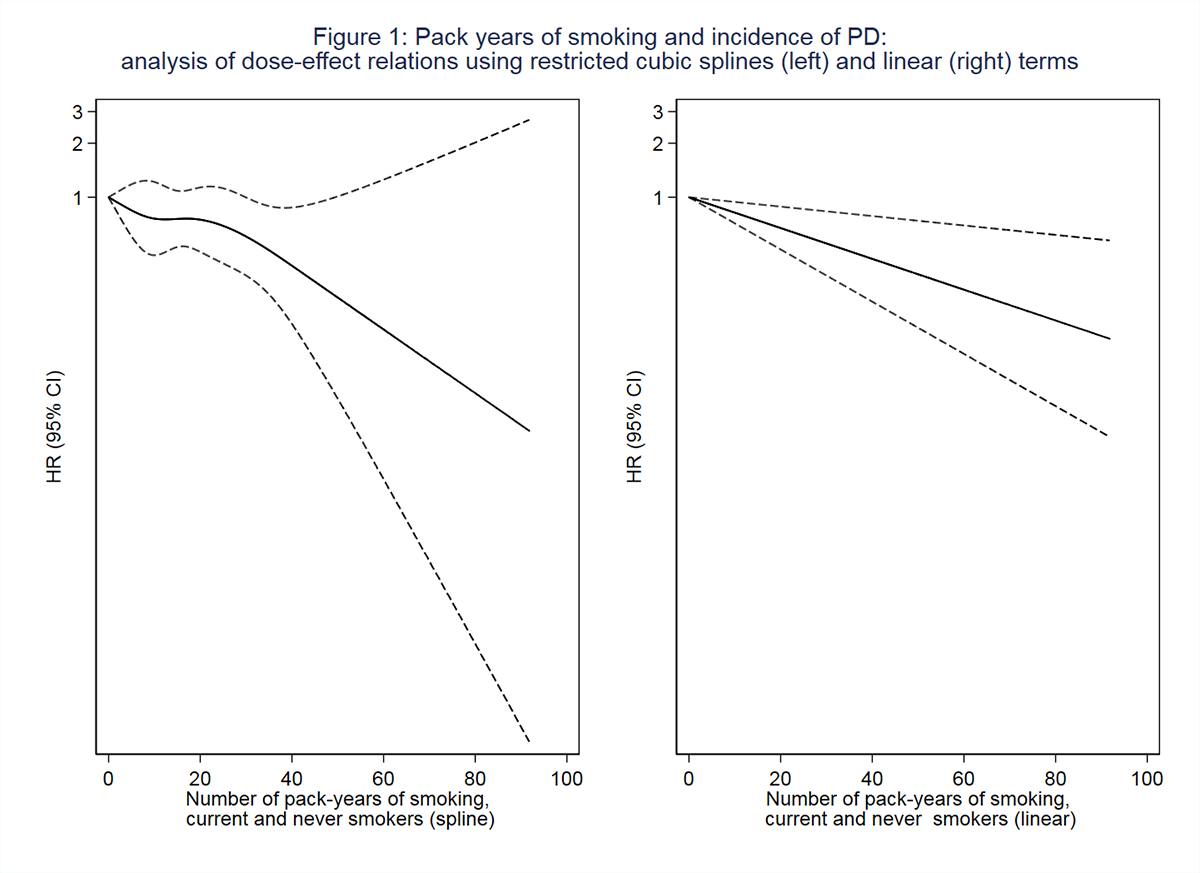Session Information
Date: Wednesday, September 25, 2019
Session Title: Epidemiology
Session Time: 1:15pm-2:45pm
Location: Les Muses, Level 3
Objective: To investigate the association of active and passive smoking with Parkinson’s disease (PD) incidence in women over 25y of follow-up.
Background: PD is the second more frequent neurodegenerative disease after Alzheimer’s disease. Its incidence is relatively low and it is 1.5 times more frequent in men than women; therefore, few cohort studies with a long follow-up have examined the association between active and passive smoking with PD incidence in women.
Method: E3N is an ongoing cohort study of 98,995 French women aged 25-40y in 1990, affiliated with a health insurance plan that primarily covers teachers. They have been followed every 2-3y since (9 waves of data collection) by self-administered questionnaires on lifestyle and medical history [1]. In addition, women are passively followed through drug claim databases since 2004 and death certificates are available for women who died. Active (never/ex/current; number of years of smoking and number of cigarettes/day) and passive smoking (yes/no; during childhood or adulthood) were self-reported at baseline and 2y after (1992) respectively. Incident PD cases were identified until 2014 based on self-report and drug use. Diagnoses were validated based on medical records; when not available, we used a validated algorithm based on drug claim databases to define PD cases [2]. Hazard ratios (HR) and 95% confidence intervals (CI) were estimated by Cox proportional hazards models with age as the time scale.
Results: Between 1990-2014, we identified 929 incident PD cases (816 after 1992). At baseline, 64% of the women were never smokers, 31% past smokers, and 15% current smokers. Compared to never smokers, current smokers had a decreased risk of PD (HR=0.80; 95%CI=0.64-0.99), with significant dose-effect relations for duration (p=0.02), intensity (p<0.01), and pack-years (p<0.01) of smoking [figure1]. After exclusion of cases occurring during the first 20y of follow-up, HRs remained unchanged (345 cases; HR=0.83 [0.58-1.18]). There was no significant association for ex- (HR=0.94 [0.81-1.09]) and passive smoking (childhood, 70.9%, HR=1.06 [0.91-1.24]; adulthood, 55.6%, HR=1.02 [0.89-1.18]).
Conclusion: We confirm an inverse association between current active smoking and PD in women, even when smoking was assessed 20y before PD onset. Our results are not in favor of an association of passive smoking with PD.
References: 1. Clavel-Chapelon F, Group ENS. Cohort Profile: The French E3N Cohort Study. Int J Epidemiol. 2015;44(3):801-9. 2. Moisan F, Gourlet V, Mazurie JL, Dupupet JL, Houssinot J, Goldberg M, et al. Prediction model of Parkinson’s disease based on antiparkinsonian drug claims. Am J Epidemiol. 2011;174(3):354-63.
To cite this abstract in AMA style:
M. Canonico, F. Artaud, D. Cerasuolo, I. Degaey, P. Gerbouin-Rerolle, A. Kowal, E. Roze, G. Severi, MC. Boutron-Ruault, A. Elbaz. Association of active and passive smoking with Parkinson’s disease in women: the E3N cohort study [abstract]. Mov Disord. 2019; 34 (suppl 2). https://www.mdsabstracts.org/abstract/association-of-active-and-passive-smoking-with-parkinsons-disease-in-women-the-e3n-cohort-study/. Accessed December 13, 2025.« Back to 2019 International Congress
MDS Abstracts - https://www.mdsabstracts.org/abstract/association-of-active-and-passive-smoking-with-parkinsons-disease-in-women-the-e3n-cohort-study/

